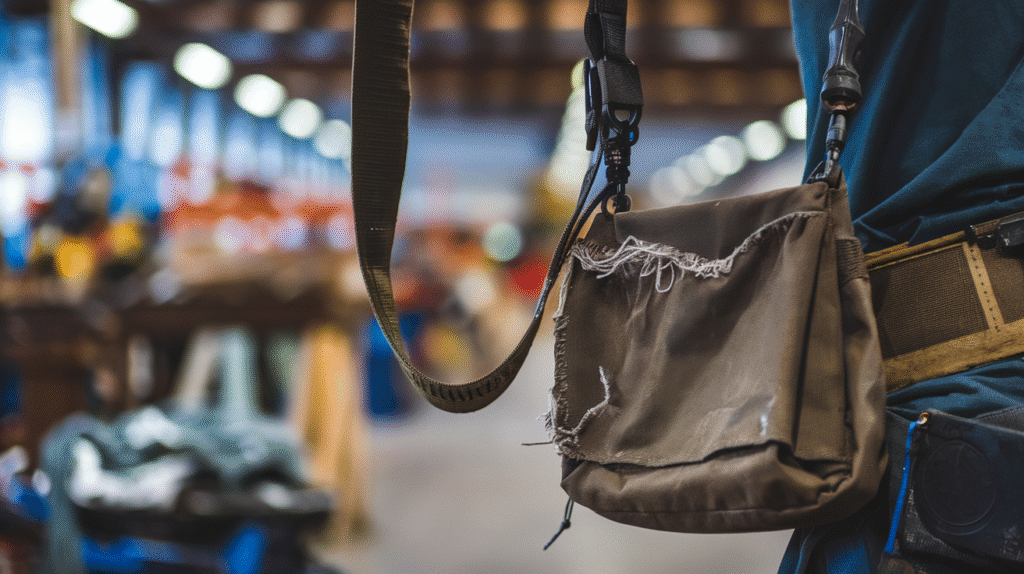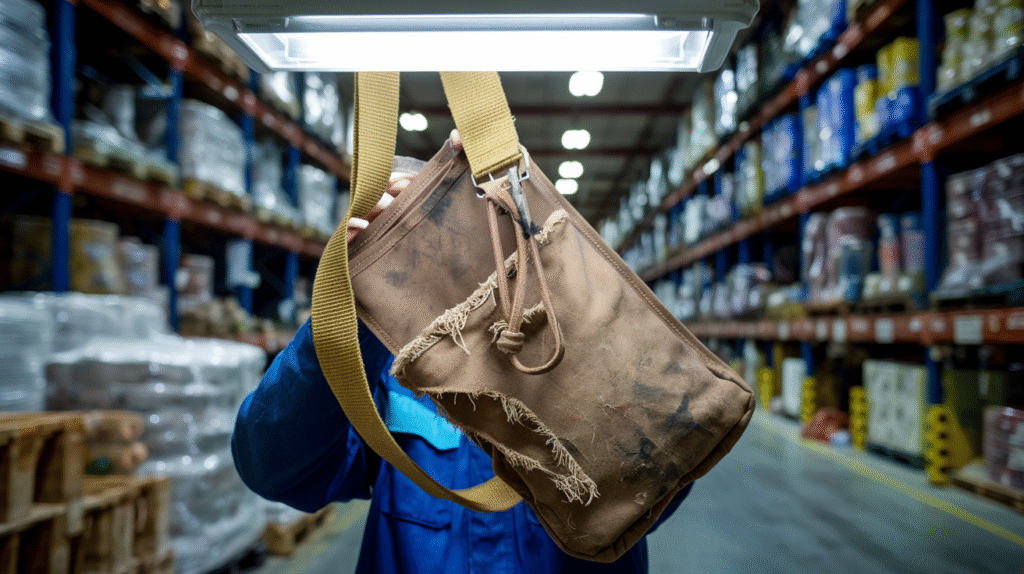
Slings are essential tools, but many users often wonder, “when can you use damaged or defective slings?” Understanding the situations when a sling may still be safe and effective is important to avoid potential hazards. While slings may appear broken or damaged, they can sometimes still be used, but it depends on the extent of the damage. The key is to assess whether the sling still performs its function without compromising safety. A broken cord, a torn pouch, or a fraying edge may seem insignificant, but they can impact how well the sling works, and even small defects can pose risks.
Before you decide to use a damaged or defective sling, it’s crucial to inspect its construction carefully. Even the slightest damage could lead to unpredictable results, especially in combat situations or survival scenarios. If the sling’s core function – the ability to launch a projectile with enough force – is not impaired, it may be safe to use for non-critical tasks. For instance, if the pouch is torn but still holds projectiles well, or the cords are frayed but not yet fully broken, you might be able to use it temporarily. However, if the sling is significantly damaged to the point that it no longer holds projectiles securely or the cords risk snapping during use, it’s time to retire it for safety reasons.
Table of Contents
Understanding When You Can Use Damaged or Defective Slings Safely
When a sling shows signs of damage, it can be tempting to continue using it, but understanding when it’s still safe to use is crucial. Always inspect the sling closely before using it again. Minor fraying or small tears might not affect its performance, but significant damage could lead to the sling breaking mid-use. It’s important to check the condition of both the cords and the pouch. If either is too damaged, it can cause the projectile to fly unpredictably or even cause injury. You should only use a damaged sling if the defect does not compromise its overall performance. Always prioritize safety over convenience to avoid accidents.
Signs Your Sling Is Still Usable: When Can You Use Damaged or Defective Slings

To determine if a damaged sling is still usable, you must assess whether it can still perform its job without posing any risk. If the cords are frayed but not broken, and the pouch is still holding projectiles securely, the sling may still be functional. However, if the pouch is torn to the point where it can’t hold the stone or projectile firmly, or the cord is close to snapping, it’s no longer safe to use. Small wear and tear on a sling may be acceptable for light use, but for high-intensity activities like combat or survival situations, it’s better to replace it to ensure accuracy and safety.
Assessing Sling Damage: Is It Safe to Use a Defective Sling
Assessing sling damage involves closely inspecting both the cords and the pouch. If the cords are fraying but not fully damaged, and the pouch still holds projectiles, the sling might still be used for low-risk tasks. However, damage to the pouch that affects its ability to hold projectiles securely is a major concern, as is any damage to the cords that could lead to the sling breaking during use. When a sling is defective, it is essential to evaluate the extent of the damage. If there’s any doubt, it’s safer not to use the defective sling. Always remember, safety should come first.
How to Inspect and Decide When You Can Use Damaged or Defective Slings
Inspecting a damaged or defective sling requires a close look at its construction. Start by checking the cords. If the cords are fraying, are there any exposed fibers that might snap during use? Next, inspect the pouch to ensure that it can still securely hold a projectile. If the pouch is torn or loose, the sling will be ineffective. Finally, check the knots and any additional components to ensure they are still intact. If any part of the sling is compromised, it’s better to repair or replace it. Only use the sling if you’re confident that the damage does not affect its performance.
The Risks of Using Damaged or Defective Slings and How to Avoid Them
Using a damaged sling carries significant risks, including the possibility of the sling breaking during use, causing inaccurate projectile flight, or even injury. A compromised sling may lead to the loss of control over the projectile, making it harder to hit the target and increasing the risk of hitting unintended targets. If the sling breaks in the middle of a throw, the user might also suffer from an unexpected recoil or strain. To avoid these risks, always inspect the sling before use and retire any slings that show signs of significant wear. Regular maintenance and repairs can help keep your slings in good working order.
What Happens When You Use a Defective Sling: Safety Considerations

When you use a defective sling, several things can go wrong. The most common issues are that the projectile may not fly as intended, which can make it dangerous. A broken cord could cause the sling to malfunction and even cause injury. Furthermore, a poorly constructed sling can lead to inaccurate shots or the projectile dropping prematurely, which could impact your aim. If you’re using the sling for hunting, defense, or any form of combat, this can be particularly hazardous. Safety should always come first, so check for defects before use and avoid using a sling that might fail when you need it most.
Temporary Use of Damaged Slings: When Can You Use Them in a Survival Situation
In a survival situation, you may not have access to a new sling, so it might be tempting to use a damaged one. If the damage is minor, like slight fraying of the cords or a small tear in the pouch, you may still be able to use it temporarily. However, always be aware of the risks. The sling may not perform as efficiently, and the damage could worsen with each use. When possible, repair the sling or use it only for less critical tasks. Make sure the damage does not affect its overall ability to secure and launch projectiles. Always prioritize your safety and survival needs.
Is Your Sling Still Effective: A Guide to Using Damaged or Defective Slings
To determine if a damaged sling is still effective, check the condition of the sling’s cords and pouch. If the cords are fraying but still intact, and the pouch is not torn, it may still work for lighter tasks. However, if the pouch can no longer hold projectiles properly or the cords are likely to break, it’s time to stop using the sling. A defective sling can lead to inaccurate throws and potentially dangerous outcomes. In high-risk situations like hunting or self-defense, it’s better to use a fully functional sling. Don’t risk your safety by using a defective one for these tasks.
When Can You Use Damaged or Defective Slings for Hunting and Combat
Using a damaged sling for hunting or combat is not recommended unless the damage is minimal. A defective sling might lead to unpredictable projectile flight or even failure during use, which could be dangerous. Always check the sling carefully before using it in a critical situation. If the pouch is intact and the cords are still holding up well, it might be safe for short-term use. However, if the sling is significantly damaged or worn, it’s best to retire it or replace it with a more reliable option. Safety and accuracy are crucial, especially when using a sling for hunting or combat.
Preventing Accidents: Understanding When You Can Use Damaged or Defective Slings

Accidents often happen when we ignore small issues with tools like slings. To prevent accidents, always understand when a damaged sling is still usable. If the damage to the sling is minor and doesn’t affect its function, it might still be safe for light tasks. However, always check the cord and pouch carefully to ensure they are secure. If the sling shows signs of significant wear or tear, it’s best to stop using it and repair or replace it. By inspecting the sling before each use and making necessary repairs, you can reduce the risk of accidents and ensure safe use.
Conclusion
While it may be tempting to continue using a damaged sling, safety should always be your priority. A damaged or defective sling can compromise its performance and cause accidents or injuries. It’s essential to assess the extent of the damage, whether it’s to the cords or the pouch, before deciding if it’s safe to use. If there’s any doubt about the sling’s effectiveness or safety, it’s better to retire the sling and find a replacement.
Remember, slings are simple tools, but their function depends on being in good condition. Always inspect your sling carefully, especially if it’s showing signs of wear and tear. If you ever find yourself in a survival situation and need to use a damaged sling, make sure it’s safe to use and doesn’t pose a risk. By staying cautious and inspecting your slings, you can avoid accidents and ensure their effectiveness when you need them most.
FAQs
Q: Can I still use a sling if the pouch is slightly torn?
A: Yes, if the pouch can still hold the projectile securely, it might be safe for light use. But if it affects the accuracy, it’s best to repair it.
Q: What should I check before using a damaged sling?
A: Inspect the cords for fraying and the pouch to ensure it holds projectiles securely. If the damage affects either part, avoid using it.
Q: How do I know if my sling is too damaged to use?
A: If the cords are severely frayed, or the pouch cannot hold projectiles properly, the sling is too damaged and should be replaced.
Q: Can I use a damaged sling in a survival situation?
A: Yes, but only if the damage is minor and does not affect the sling’s performance. Ensure safety before using it in such situations.
Q: What are the risks of using a defective sling?
A: A defective sling can lead to inaccurate throws, failure to launch the projectile, or even injury if the sling breaks mid-use. Always inspect it carefully.

